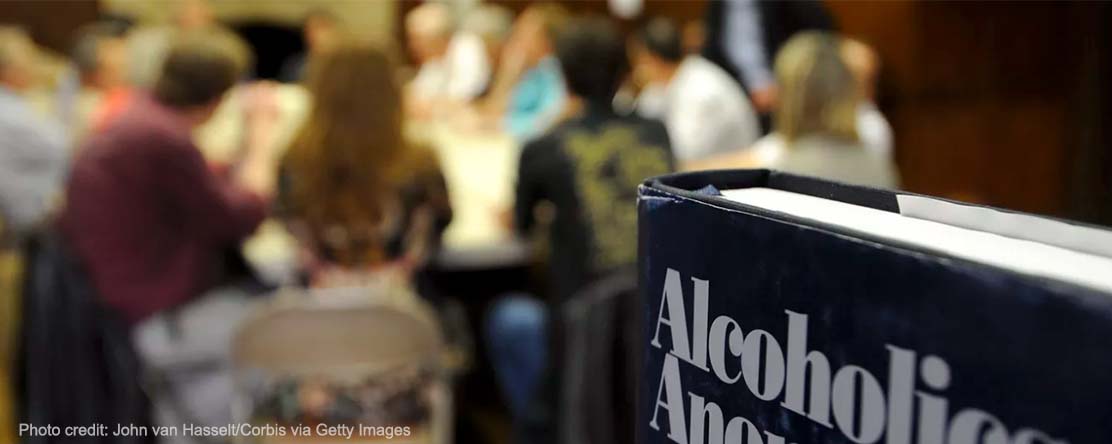
In the News
SMART, LifeRing, and Women For Sobriety Are as Effective as AA, Study Shows
-
Focus Areas
Alcohol, Tobacco, Drugs & Mental Health -
Issues
Alcohol -
Programs
Alcohol Research Group

“A lot of people don’t like AA, and someone may be deterred from going to treatment if they feel like they need to go to AA, specifically because of the spiritual emphasis.”
 AA has been the go-to treatment modality for those caught in the throes of Alcohol Use Disorder (AUD) for over 80 years. Whether in the medical sphere or the public consciousness, recovery from AUD is commonly perceived as total abstinence from alcohol through AA attendance. Only recently has conversation sparked around alternative mutual support groups, and awareness of these groups has remained limited among people with AUD, the medical community, our criminal justice system, and the public in general.
AA has been the go-to treatment modality for those caught in the throes of Alcohol Use Disorder (AUD) for over 80 years. Whether in the medical sphere or the public consciousness, recovery from AUD is commonly perceived as total abstinence from alcohol through AA attendance. Only recently has conversation sparked around alternative mutual support groups, and awareness of these groups has remained limited among people with AUD, the medical community, our criminal justice system, and the public in general.
A groundbreaking new study published in the Journal of Substance Abuse Treatment called Peer Alternatives in Addiction (PAL) might bring some of these alternatives into sharper focus. It tracks the success outcomes of participants from AA, LifeRing, Women For Sobriety, and SMART Recovery over the course of 12 months, making it the first longitudinal study on alternative support groups. After controlling for demographic variables and other variables, including the severity of participants’ AUD, psychiatric diagnoses, and abstinence goals, researchers have concluded that alternatives to 12-step programs are likely as effective in treating AUD as AA.
The study defines successful outcomes as total abstinence from alcohol along with a decrease in problems associated with alcohol use. One key difference found between alternative support groups were the goals set by participants—a lesser percentage of those with a Primary Group Affiliation (PGI) of LifeRing and SMART Recovery had a goal of lifetime total abstinence compared to those with an AA PGI. On the surface, this makes outcomes for LifeRing and SMART appear worse, as fewer participants in both programs maintained abstinence, but the discrepancy, known as selection effects, disappears after accounting for their recovery goals.
“When you control for recovery goals, all differences between groups go away. So that’s sort of the bottom line,” Dr. Sarah Zemore, lead author of the study and Senior Scientist and Center Associate Director at the Alcohol Research Group, told The Fix. “Yes, we do have some selection effects. I don’t think it’s surprising that you do find differences in recovery goals across groups, just anecdotally people report more pressure to be completely sober in 12-step programs verses the alternative groups. From what I understand people feel a little more welcomed in the alternatives if they’ve had a lapse.”
Anyone who’s attended AA for some time has either experienced or witnessed a relapse. It’s a big deal: you “give up your time” and start over while you try to figure out where you went wrong; maybe you didn’t work the steps or failed to “surrender.” This contrasts with the philosophy of SMART that acknowledges that lapses and relapses—though not encouraged—are relatively common. The SMART Recovery workbook states “If you lapse or relapse, don’t let it lead to crushing self-reproach and guilt. It’s better to accept the temporary setback as a normal part of change and growth rather than to call your recovery a failure and give up. Handled well, a lapse or relapse can be brief and provide another opportunity for self-empowerment.” Putting too much analysis and weight into a slip can be counterproductive—this was my personal experience. Having a more realistic approach, one that doesn’t criticize you or your “program” if you relapse, can make it easier to hop back on the horse.
The key predictor of success in all of the groups was active group involvement, measured by having a regular meeting (or “home group”), having a close friend or a sponsor, maintaining a strong social support network within the group, and having a role in meetings such as making coffee or setting up chairs. This adds some challenge for those wanting to participate in alternative groups. In Los Angeles, for example, on any given week you can find over 4,000 AA meetings, but if you want to attend SMART Recovery you only have approximately 20 in-person meetings to choose from. This is no small matter when involvement—especially via social interaction—is the greatest predictor of success. But if AA continues to be recommended, portrayed in media, and referred to by the court as the choice program of recovery for anyone struggling with alcohol, there’s little reason for people to seek out alternatives, be they clinicians or those with AUD. Hence the importance of generating awareness of alternative groups’ efficacy.
“One of the goals of the study was to see if the groups were effective, and if they were effective to bring awareness to them, because that’s the only way they’re going to spread. Formal treatment, especially public treatment, is so tightly tied to AA,” Dr. Zemore said. “A lot of people don’t like AA, and someone may be deterred from going to treatment if they feel like they need to go to AA, specifically because of the spiritual emphasis. I think for the atheist or agnostic it can be a hard pill to swallow. I’d like for people to have choice because I feel like it could help them access and utilize treatment broadly and form the kinds of networks they need in order to recover.”
After the findings of the study were released, SMART Recovery published a statement: “This research sends a powerful message to counselors, clinicians, physicians and public health advocates that people suffering from serious addictions can find help in many different groups, meetings and programs. We strongly encourage more addiction scientists to continue exploring the many pathways to recovery.”
Research is necessary, but research isn’t always easily attained. Dr. Zemore found it difficult to obtain funding for the study.
“Some of the critiques I got when I first embarked on this line of research suggested that there wasn’t any point to studying alternative mutual groups because the numbers just weren’t there,” she said. “Twelve-step groups were and are far more common, so some of my colleagues felt like these groups were a ‘sideshow,’ too small to matter. Of course, my perspective was and is that the alternatives I studied have the potential to grow. I was kind of looking into the future and imagining that, with a good evidence base on mutual help alternatives, providers would be increasingly willing to refer people to these groups, and treatment programs would be increasingly likely to offer these alternatives onsite—and that would then spur their growth.”
I began attending SMART Recovery and Refuge Recovery, a Buddhist-based program that also encourages abstinence, after leaving AA in 2015. Both programs proved highly effective in taming my maladaptive mind-chatter that makes weathering life’s ups and downs so difficult without the anesthetization of alcohol. But these programs had a limited number of meetings, and, as a result, not as many opportunities to connect with others in person. So I decided a few months ago to drop into AA every now and again, mainly because I could do so last-minute if I was going through a rough spell and wanted to be around people who were wired like me. I could find meetings close by almost on the hour.
Gabrielle Glaser’s article “The Irrationality of Alcoholics Anonymous” in The Atlantic prompted my leaving the program. She wrote a cogent piece illustrating why 12-step should no longer be the default treatment for those struggling with AUD. On one hand, she didn’t dismiss the program’s effectiveness entirely, but she did argue that the program can do more damage than good for many people, that evidence-based practices should be the treatment standard, and that abstinence is not always the best metric for recovery. The most urgent matter for Glaser was creating awareness that alternative treatment modalities exist.
Despite agreeing with most of Glaser’s points, in addition to agreeing with Lance Dode’s arguments in The Sober Truth: Debunking the Bad Science Behind 12-Step Programs and the Rehab Industry, I believed I could still trickle back into AA. I could drop in to meetings when needed and take advantage of the social network whilst disagreeing with many aspects of the program and attending alternative mutual support groups. An AA fundamentalist might accuse me of having one foot in and one foot out of AA since I am casually attending meetings whenever the need arises, am not a sponsor, don’t have a sponsor, am not revolving my life around the program, and am not regularly “being of service” within the context of the program. Considering these circumstances, they might argue that I am therefore not participating in the program as outlined in the book, which might lead to relapse. But if the only requirement for AA membership is a desire to stop drinking, then AA itself ultimately allows for this kind of attendance and my personal philosophy on recovery.
“People who attend alternatives often also attend AA, so there is a fair amount of overlap. So I think one interesting point about this is you really don’t have to choose, and I think that’s probably the common mentality,” said Dr. Zemore. “It’s either AA or an alternative, but they aren’t diametrically opposed. In practice, there are many things that are quite similar, and many people benefit from going to multiple groups, and that’s quite fascinating. And I think that’s what I’d actually really like to see happen, is people trying multiple groups and seeing what really works for them.”
Originally published by The Fix
More Updates
Work With Us
You change the world. We do the rest. Explore fiscal sponsorship at PHI.
Support Us
Together, we can accelerate our response to public health’s most critical issues.
Find Employment
Begin your career at the Public Health Institute.



